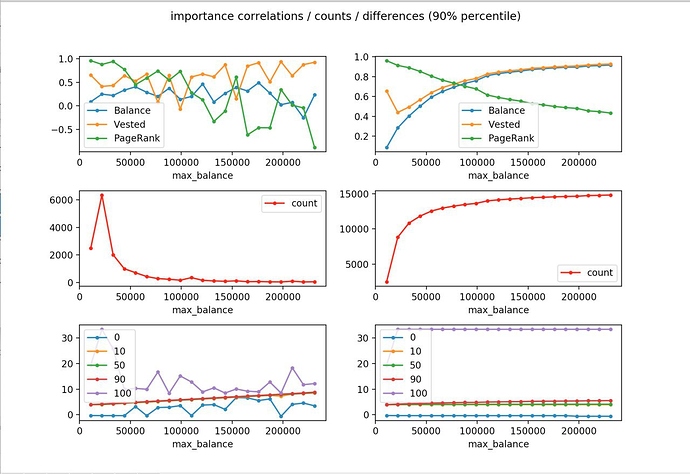So, based on the graph top right, it looks as though the larger the balance of an account, the lesser effect that the PoI aspect of the consensus algo has on an accounts importance. ie. an account with 500k xem vested balance that has never been active would have an importance of roughly 90% of what it would, had pure proof of stake been used, and an account with 50k xem that has never been active would lose 10% its importance vrs PoS, or close to double its importance should it be highly active.
The effect of PoI on large accounts can be confirmed by looking at the POST V1 fund in the rich list, which has an importance of about ~0.09 and is why i first asked about the actual effect of PoI vrs PoS.
It makes sense that smaller accounts would see an unequal gain in importance vrs much larger accounts, because all large accounts can lose importance but only accounts with >10k xem balance can gain importance. so there is an uneven redistribution of any lost importance, all other things being equal.
The question id ask about this is, is the effect of PoI actually worth having a resource intensive algorithm to calculate it? And, if we increase the effect of importance calc vrs stake, what are the potential risks/ramifications?
Personally i don’t think a 10% hit for a dead account with 10% of the supply is enough of a hit. It should deteriorate much much more because in its inactive state, its worthless to the network, but that could be an issue.
If the much larger, and usually much more dormant accounts, lose say, 60% of their importance to the smaller/active accounts, its increasing the risk of a 51% through redistribution of importance to other coins, therefore requiring far less xem to perform an attack, simply because larger accounts go dormant.
Of course we cannot enforce that the larger accounts be active, so increasing the effect of importance vrs stake would in turn increase the potential risk of a 51% attack. Even now, you need <50% of all coins to do a 51% attack due to the redistribution of importance. The more you decrease the effect of stake vrs importance, the more you increase 51% attack risk, which is why i suspect the core devs kept it to a maximum correlation of 0.1. So i also suspect we cannot increase the effect of PoI because of the potential increased risk of 51% attack.
So really, we are actually trading security for inclusiveness. Although PoI is more egalitarian, as it was intended to be, its actually less secure from what i can tell and a lot more resource intensive than PoS while not actually having enough of an effect to be as egalitarian as it was initially envisioned to be, and for that reason i would suggest that catapult be launched with pure proof of stake vrs PoI.
To top it off, PoI is going to need a complete port to C++ while there is already a C++ PoS implementation (ProximaX already has this done for all those who are giving out about proximaX) that can be adopted - reducing demands on dev time before catapult launch.
This is mostly just my brain dumping so please someone correct me if any if i’m off base on any of this.


